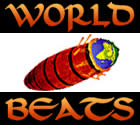|
Are played with the sticks and consist of two single-skinned, metal-shelled cylindrical-shaped drums. The "timbales" are actually a mutation of a drum that migrated originally out of India and Africa years ago in the shape of giant kettle drums that were strapped to the sides of camels, horses and elephants. Eventually this drum made its way to Europe and Spain, and had mutated and shaped to what is known today in Europe and the West as the, "Timpani" drums. Cuban music is a melting pot of African and Spanish (European) influences and cultures. Well over half the slaves brought to Cuba were from the Congo, while the others came from the Yoruban populations of West Africa (Nigeria, Benin, etc.). They brought the rhythms and drumming of their religions which gave way to Santeria in Cuba, Vodou in Haiti, and Candombe in Brazil. To this day, the Yoruban languages of western Nigeria, Benin and Kikongo from the Congo are spoken and sung in Cuba. The shells are made of either brass or steel and set on a stand. The larger timbale, called "hembra" (pronounced embrah), and the "cha cha" bell (smaller bell), are traditionally positioned to the left side of the "timbalero" (one who plays the timbales). The "macho" timbale (smaller drum), the "mambo" bell (larger bell), and the "cymbal" are traditionally positioned to the right of a right-handed player. "Cascara" literally means "shell" in Spanish, and the "paila" or cascara is the traditional pattern played by the timbalero player on the side of the macho timbale (smaller drum) It can also be played on the cymbal, cowbell or woodblock. In some cases, Cuban musicians will use the word "pailas" for the timbales and "cascara" for playing on the shell or sides of the drums. All patterns are based on the clave and emphasize the accents within the rhythm.
The WORLD BEATS video features live, costumed performances of ancient, ethnic, percussive traditions. Aaron Plunkett puts it all together in this fascinating 33 minute program. SEE MORE... |

